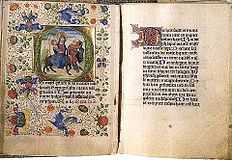Stefan Lochner
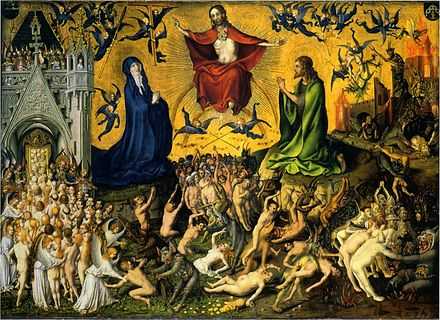
Stefan Lochner (c. 1410 – 1451) was a German painter working in the late International Gothic style. He produced panel paintings, often altarpieces, and illuminated manuscripts. As there are few surviving records of his life, he was long known as the name of convenience The Dombild Master. Research by art historians in the 19th century associated that master's painting with Lochner, and the outlines of a biography have been established. Today 33 works, dated between the early 1430s and c. 1450, are attributed to him with varying degrees of confidence;[1] due to lack of documentary evidence many attributions remain problematic.[2] Circumstantial evidence suggests he died during an outbreak of plague in the winter of 1450/51.
Lochner was active in Cologne, Germany, and is best known for the Altar of the City Patrons triptych, commissioned for the Town Hall chapel in the 1440s and now in Cologne Cathedral. Lochner was one of the most important German artist before Albrecht Dürer; an artist who held Lochner in great esteem and is most identified with continuing his legacy.[3]
Lochner was one of the last major painters working in the "soft style" (weicher Stil) of the International Gothic tradition. His work is known for its clean appearance, virtuoso surface textures and innovative iconography. He was praised by Friedrich Schlegel and Goethe for the "sweetness and grace" of his Madonna portraits.[4] His paintings combine a Gothic tendency towards long flowing lines in brilliant colours with a Flemish-influenced realism and attention to detail. Lochner's compositions often include fanciful angels, singing and playing musical instruments. He was skilled both as a miniaturist and a painter of monumental works. He seems to have had knowledge of metal work, given his realistic depictions of objects such as the Magi's gifts in the Cologne altarpiece.[4]
Life
Early life, Meersburg
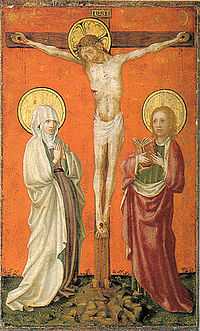
The known details of Lochner early life are scant, not helped by the destruction of local archival records during the French occupation of Cologne.[5] He is thought to have come from Meersburg, near Lake Constance, as his parents, Georg and Alhet, were citizens and are recorded as having died there in 1451. He is referred to as "Stefan Lochner of Constance" twice in documents, in 1444 and 1448.[6] However there is no archival evidence that he was there, and his style bears no traces of the art of that region.[7] Recent research has found no record of him or his family in the town, although there is mention of Lochner's (a fairly uncommon name) in the village of Hagnau, two kilometers from Meersburg.[6]
Lochner's talent was recognised from an early age.[8] He may have been of Netherlandish origin or worked there for a master, possibly Robert Campin. His work seems influenced by Jan van Eyck and Rogier van der Weyden; elements of their styles can be detected in the structure and colourisation of his mature works, especially in his Last Judgment,[9] although neither is thought to be the master under whom he had studied.[10]
Move to Cologne


He first appears in surviving records in 1442; nine years before he died.[1] Lochner had moved to Cologne, commissioned by the city council for decorations in connection with the celebration of the visit of Emperor Frederick III. He was already a master at this stage, and although other artists were involved in preparing for the celebration, Lochner was responsible for the most important decorations; the resulting Dombild Altarpiece has been described as "the most important commission of the fifteenth century in Cologne".[11] He is recorded as having been paid forty marks and ten shillings for his effort.[5]
The city had a long tradition of producing high end visual art, and in the 14th century its output was considered equal to Vienna and Prague. In the 15th century its artists concentrated on more personal, intimate and homely forms, and the area became known for its production of small panels of "great lyrical charm and loveliness, which reflected the deep devotion of the writings of the German mystics".[12]
By the 1430s, painting in Cologne had become conventional and somewhat old fashioned, still under the influence of the International courtly style of Master of Saint Veronica, known to have been active until 1420.[13] After his arrival, Lochner, exposed to the Netherlandish artists and working with oil,[14] eclipsed other artistic work in the city.[15] According to art historian Emmy Wellesz, after Lochner's arrival "painting in Cologne became infused with a new life", perhaps enriched by the earlier exposure to the Netherlandish artists.[12] He became widely celebrated as the most capable and modern painter in the city, where he was known as "Maister Steffan".[16]
Sucess, city councilor
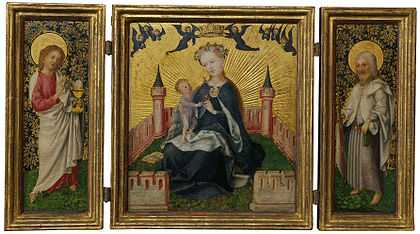
Lochner bought a house around 1442 with his wife Lysbeth. Nothing else is known about her, and the couple apparently had no children.[5] In 1444 he was able to afford to sell it for two larger properties, one named "zome Carbunckel", near Saint Alban Church,[17] and another called "zome Alden Gryne".[11] Historians have speculated whether the acquisition of larger premises indicates increased activity on his behalf, and a need for a larger space to accommodate an increased workshop and additional assistants. It is likely that he lived in one house, and worked in the other.[11] The purchases may have strained him financially, as around 1447 he seems to have encountered financial difficulties, forcing him to remortgage both. Second mortgages were taken out in 1448.[5]
He was elected in 1447 by the local painters guild to serve as Ratsherr; their representative municipal councilor. The appointment implies he had lived in Cologne since at least 1437, as only those who had been living in the city for ten years could take up the position. He seemingly had not taken up citizenship immediately, possibly to avoid paying the 12 guilder fee, and anyway the guild did not require it. However he was obliged to as Ratsherr, and on 24 June 1447 became a burgher of Cologne.[18] The role of municipal councilor could only be held for a one-year term, with two years vacated before it was occupied again. In this way, Lochner was re-elected for a second term in the winter of 1450, which was cut short by his death.[5]
Plague, early death
Germany was undergoing an outbreak of plague in 1451, and there are no surviving records of him after Christmas of that year. On 16 August the council of Meersburg was informed by the council of Cologne that Lochner would not be able to travel to attend to the will and estate of his parents, who had recently died.[6]
It is presumed he was then already ill. The area Lochner was living in was particularly affected by the outbreak; on 22 September his parish of Saint Alban requested permission to burn plague victims in a lot next to his house as the cemetery was full. He died sometime between this date and January 1452, when a creditor took possession of his house, indicating that he had been unable to pay off his debts, perhaps because he had been ill for some time.[19] The latter record does not mention Lysbeth, who was presumably already dead.[6]
Identity and attribution
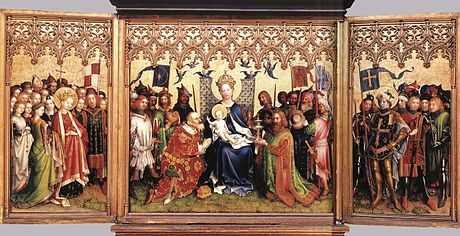
There are no signed paintings by Lochner, and his identity was not established until the 19th century. The determination of his identity took place in two stages. Firstly, in an article published in 1823, J. F. Böhmer identified the Altar of the City Patrons with a work mentioned in an account of a visit to Cologne in 1520 in the diary of Albrecht Dürer, during which the notorious thrifty artist paid 5 silver pfennig[21] to see an altarpiece by "Maister Steffan", some seventy years after Lochner's death.[22] The description given matches exactly the "Adoration of the Magi" center panel of the Altarpiece of the City's Patron Saints, now at Cologne Cathedral.
The altarpiece is mentioned in a number of later records. It was repaired and re-gilded in 1568, and mentioned in Georg Braun's "Civitates Orbis Terrarum" in 1572. German Gothic art underwent a revival in the early 19th century Romantic period, when the work was seen as a climax of the late Gothic period. The German philosopher and critic Friedrich Schlegel was instrumental in reviving Lochner's reputation; he wrote lengthy tracts, comparing it favourably to the work of Raphael, and proposing that it exceeded anything by van Eyck, Dürer or Holbein.[23] Later, Goethe was enthusiastic -at length-[19] emphasising Lochner's German "spirt and origion", yet described the Drombild as the "axis around which the ancient Netherlandish art resolves into the new."[24]
However the artist's identity remained unknown, and he was referred to simply as the "The Dombild Master", with no other known associated works.[19] In 1816 Ferdinand Franz Wallraf identified him as Philipp Kalf, based on a reading of an name inscribed on the sheath of a figure on the right of the center panel. He also misinterpreted markings on the stone floor of the "Annunciation" to read 1410, which he took as the year of completion.[25] Later, Johann Dominicus Fiorillo discovered a 15th-century record that read "in 1380 there was an excellent painter in Cologne called Wilhelm, who had no equal in his art and who depicted human beings as if they were alive".[26]
In 1850 Johann Jakob Merlo identified "Maister Steffan" with the historically recorded Stefan Lochner.[27]
Over the years, based on their stylistic similarity to the Altar of the City Patrons, other paintings have been attributed to him, although in recent years some art historians have questioned that the diary entry was authentically made by Dürer. Other documentary evidence linking the paintings and miniatures with the historical Lochner has also been challenged, most notably by art historian Michael Wolfson in 1996.[3] In either case, the extent of his direct hand, as opposed to those of workshop members or followers, is debated.[28] Some panels formally attributed to him are now thought to date from after 1451, the year of his death.[29]
Style
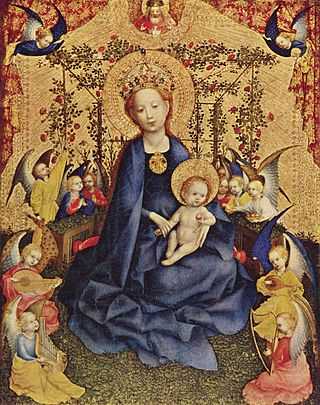
Lochner worked in the then old fashioned courtly International Gothic style.[30] Yet he introduced a number of innovations to painting in Cologne, especially in filling his backgrounds and landscapes with specific details, giving his figures more volume, and representing receding space (perspective).[31] His paintings were described by art historian Emmy Wellesz as sharing an "intensity of feeling which gives a very special and very moving quality to his work. His deep devotion is reflected in his figures: it charges with symbolic meaning the smallest details of his paintings; and, in a hidden, almost magical way, it speaks from the concord of his pure and glowing colours."[32]
Lochner painted with oil and resin as binding materials, and his colour schemes tend to be bright and luminous, especially his reds, blues and greens. He often employed ultramarine, then a costly and rare pigment.[33] His figures are regularly outlined with red paint.[34] He was innovative in his rendering of flesh tones, which he built up using lead whites to give pale complexions with almost porcelain qualities. In this he was referring to a very old tradition in indicating women of high nobility; their paleness indicative of a life spent indoors, "shielded from toiling in the fields, which was the lot of most". In this he follows the Master of Veronica, although the earlier painter's figures had an almost yellowish, ivory hue.[35] His Madonnas tend to be clothed in saturated blues, which resonate with surrounding yellow, red and green paint.[36]
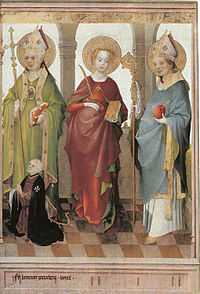
Like von Soest, he often applied black cross-hatching on gold, usually to render metallic objects such as brooches, crowns or buckles, in imitation of the work of goldsmiths on precious objects such as reliquaries and chalices.[37] Locher was heavily influenced by the art and process of goldsmithing, and evidence of his imitation of elements of their craft, from the contemporary to the ancient, is apparent even in his underdrawings; it has been suggested that he may have once trained as a goldsmith.[38]
He seems to have prepared studies on paper before he approached underdrawings; there is relatively little evidence of material reworking, even in the positioning of groups of dozens of figures. In the underdrawings for the Last Judgment panels, he used letters to denite the final colour to be applied, eg g for gelb (yellow) or w for weiss (white), and there are very few deviations in the finished work.[39] He did however often re-arrange drapery fold lines, or enlarge or diminish the size of figures.[40]
Perhaps influenced by van Eyck, he closely detailed the fall and gradient of light. According to art historian Brigitte Corley, the clothes of "protagonists change their hues in delicate reaction to the influx of light, reds being transformed through a symphony of pink tonalities to a dusty greyish white, greens to a warm pale yellow, and lemon shading through oranges to a saturated red". He employed the notion of supernatural light not just from van Eyck; but from von Soest's Crucifixion where light emanating from Christ dissolves that around John's red robe, which dissolves through yellows to become eventually white.[33] Unlike the painters in the Low Countries, Lochner was not so concerned with delineating perspective; his pictures are often set in shallow space, with the backgrounds giving little indication of distance, and dissolving into solid gold. Related to this, often the ancillary figures lack volume in their rendering. For these reasons, and because of his harmonious colour choices, Lochner is usually described as one of the last exponents of the International Gothic. This is not to say his paintings lack contemporary northern sophistication, but that his arrangements are often innovative.[41]
It is difficult to detect any evolution in Lochner's style. Art historians are unsure if his work became progressively more or less influenced by Netherlandish art. Recent dendrochronological examination of attributed works indicate that his development was not linear; suggesting that the more advanced Presentation in the Temple is of 1445, but predates the more Gothic Saints panels now divided between London and Cologne.[42]
-
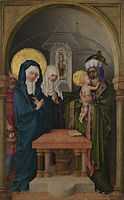
Presentation of Christ in the Temple, c 1447. Hessisches Landesmuseum Darmstadt, Darmstadt
-
.jpg)
Three Saints (Matthew, Catherine of Alexandria and John the Evangelist), c 1450. National Gallery, London
-
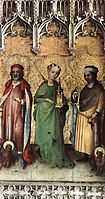
Saints Mark, Barbara and Luke, 1445–50. Wallraf-Richartz Museum, Cologne
-
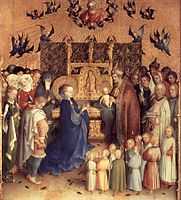
Presentation of Christ in the Temple, c 1447. Hessisches Landesmuseum, Darmstadt. The panel shows the purification of the Virgin. The Teutonic knight holds a script embroidered with holy text.[1]
- ^ Wellesz, 8
Work
Panel paintings
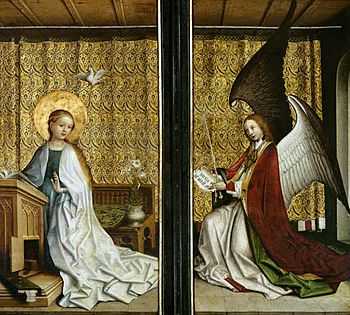
Only two attributed paintings are dated; the 1445 Nativity now in the Alte Pinakothek, Munich, and the larger Presentation in the Temple from 1447, now in Darmstadt.[19] Lochner's major works are three large polyptychs, his Last Judgement, Altarpiece of the City Patron Saints, Nuremberg Crucifixion and Martyrdom of the Apostles. Like many 15th-century religious pieces, they were broken apart over the centuries, and are today spread across various museums and collections. There are two dated versions of the Presentation in the Temple, one in the Calouste Gulbenkian Museum (1445) and another in the Hessisches Landesmuseum, Darmstadt (1447); two wings from an altarpiece, with images of saints (now in the National Gallery, London and the Wallraf-Richartz Museum, Cologne). The Crucifixion is considered one of his earliest works, reminiscent of earlier medieval painting. It has a heavily ornamented gilded background, and the smooth flowing quality of the 'soft' Gothic style. The Last Judgement is probably also from early in his career, but in subject matter and background differs from other extant and attributed works. While the elements are arranged in typical harmony, it is unusually dark and dramatic in composition and tone.[41]
In later centuries secular works grew in demand and religious works became to be seen as constricted and out of step, 15th century triptychs were often broken up and sold as individual works, especially if a panel or section contained an image that could pass as a secular portrait. Parts of Lochner's Last Judgement are in the Wallraf-Richartz Museum, while other panels from the same work are in the Alte Pinakothek in Munich and the Städel Museum in Frankfurt.[43][44]
His exant works return again and again to similar themes. The nativity is recurrent, while several panels depict the Virgin and Child, often surrounded by a chorus of angels and in his earlier panels, blessed by a hovering representation of God or a dove representing the Holy Ghost. In many instances Mary is enclosed in the usual enclosed garden.[32]
Several works evidence the work of a humber of hands, with weaker and less confident passages or scenes attributed to workshop members. The figures of Mary and Gabriel on the reverse of the Dombild were drawn more rapidly and with less skill than the figures on the main panels, and their drapery is modeled with, according to Chapuis, a certain "stiffness", while the cross hatching "achieves no clear definition of relief".[45]
A number of drawings have been associated with him, but only one, a c.1450 brush and ink on paper Virgin and Child now in the Musee du Louvre, is attributed with confidence.[46]
Illuminated manuscripts
Three prayer books survive that are attributed to him, although the extent of his involvement is debated; workshop members were probably heavily involved. One is in the State Museum, Berlin. The most famous is the Prayer book of Stephan Lochner ("Gebetbuch des Stephan Lochner") book of hours of 1451, now at Darmstadt, the other two being the "Berlin Book of Prayers" (1444). The illustrations in this work contain his characteristic application of deep blue, reminiscent of his Virgin in the Rose Garden panel. According to art historian Ingo Walther, his hand is revealed by the "pious intimacy and soulfulness of the figures, always expressed so gently and elegantly, even in the extremely small format of the pictures".[15]
-
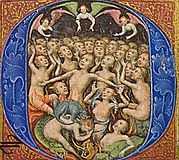
Fall of the Souls in Purgatory, "Prayer book of Stephan Lochner", 1451. The depiction of recently dead souls has to be taken in context of the 1451 outbreak of plague across Germany
-
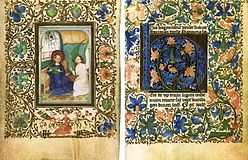
Annunciation, 1451. In the left hand miniature, the Virgin kneels on a bench in a simply furnished room. The ornate decoration and text on the opposite page has been described as of "unusual beauty". It contains words from psalm 94, the flower is an acanthus in bloom, rendered in deep blue, with pink surrounds.[1]
- ^ Cite error: The named reference
w318was invoked but never defined (see the help page).
Influences


His art seems indebted to two very different sources; Netherlandish artists van Eyck and Robert Campin,[31] and the earlier German masters Conrad von Soest and the Master of Saint Veronica. From the former Lochner drew his realism in depicting naturalistic backgrounds, objects and clothes. From the latter he adopted the somewhat antiquated manner of depicting figures, especially females, with doll-like, eloquent and sensitive features, to present "iconic, almost timeless" atmospheres, enhanced by the then old-fashioned gold backgrounds.[2] Lochner gives his figures idealised facial features typical of medieval portraiture. His female subjects especially have the usual high foreheads, long noses, small rounded chins, tucked blond curls and prominent ears typical of the late Gothic, giving them the characteristic monumentality of 13th art, placing them on seemingly similar shallow backgrounds.[47]
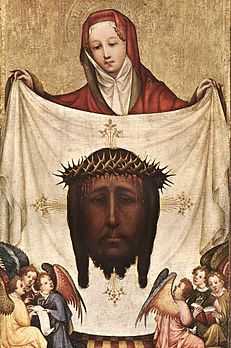
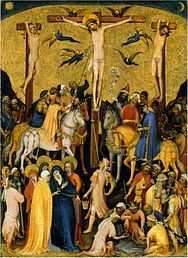
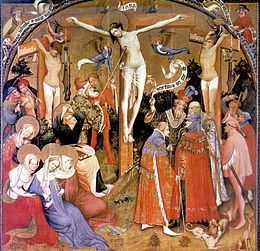
It is assumed that he saw van Eyck's c. 1432 Ghent Altarpiece during his visit to the low lands. He borrowed a number of motifs and compositional elements; most especially the Ursula and the central Dombild panels quote passages from van Eyck's "Soldiers of Christ". The similarities include the manner in which the figures engage with their space and the emphasis and rendering on elements such as brocades, gems and metals. Some figures in Lochner's paintings are direct quotes from Ghent, and a number of facial features match those seen in van Eyck.[48] His Virgin with the Violet has often been compared to van Eyck's 1439 Virgin at the Fountain.[49] Like van Eyck, Lochner's angels are often seen singing or playing musical instruments, including lutes and organs.[49]
Yet he seemingly rejected some aspects of van Eyckian realism, notably in his depictions of shadows, and his unwillingness to apply transparent glazes. As a colourist he was more inclined towards the International Gothic style, even if this inhibited realism. He disfavoured Netherlandish techniques of perspective in favour of indicating spatial recession through the diminution of parallel objects and colours.[33]
Legacy
Lochner left many followers who painted or drew in his style. Examples in ink after his Virgin in Adoration are in the British Museum and École nationale supérieure des Beaux-Arts.[50]
Evidence suggests Lochner's paintings were well known and widely copied during his lifetime, and remained popular until the 16th century. Albrecht Dürer knew of him before his stay in Cologne, and his Feast of the Rose Garlands of 1505-1506 is indebted. van der Weyden saw his paintings during his travel to Italy; the Altar of Saint John bears influences from Lochner's Flaying of Bartholomew, especially in the executioner's pose.[51] Hans Memling similarly was exposed to his work when he traveled south for a visit to Italy; and the influence of Lochner's Last Judgement can be seen in the latter's Gdansk altarpiece, where the gates of Heaven are similar, as is the rendering of the blessed.[51]
Gallery
-
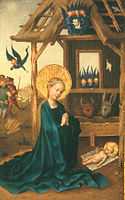
Nativity, probably 1445. Alte Pinakothek, Munich
-
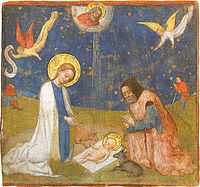
Adoration of the Child
-
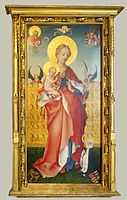
Virgin with the Violet, before c. 1450. Kolumb, Cologne
-
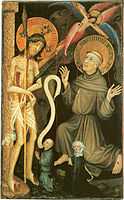
Christ as Man of Sorrow, c 1430?
-
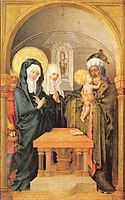
Presentation at the temple (triptych fragment), Calouste Gulbenkian Museum, Lisbon
-
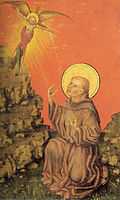
St. Francis Receives the Stigmata (triptych fragment), c 1445
-
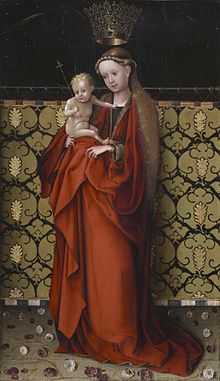
The Virgin Crowned by Angels, c. 1450. Cleveland Museum of Art. In the Netherlandish style
-
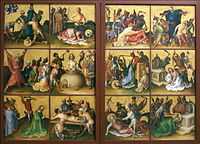
The Martyrdom of the Apostles, 1435-40. Frankfurt, Stadelsches Kunstinstitut
-
Detail: Last Judgement
-
Detail
References
Notes
- ↑ 1.0 1.1 Chapuis, 103
- ↑ 2.0 2.1 Smith, 427
- ↑ 3.0 3.1 Corley, 78
- ↑ 4.0 4.1 Borchert, 249
- ↑ 5.0 5.1 5.2 5.3 5.4 Chapuis, 26
- ↑ 6.0 6.1 6.2 6.3 Chapuis, 27
- ↑ Borchert, 248
- ↑ Borchert, 70
- ↑ Stechow, 312
- ↑ Borchert, 71
- ↑ 11.0 11.1 11.2 Chapus, 156
- ↑ 12.0 12.1 Wellesz, 3
- ↑ Corley, 80
- ↑ Nash, 206
- ↑ 15.0 15.1 Walther, 318
- ↑ Borchert, 70–71
- ↑ Singer, 16
- ↑ Chapuis, 26-27
- ↑ 19.0 19.1 19.2 19.3 Wellesz, 2
- ↑ 20.0 20.1 Wellesz, 7
- ↑ Chapuis, 28
- ↑ Rowlands, 28
- ↑ Chapuis, 14
- ↑ Chapuis, 17
- ↑ Chapuis, 16
- ↑ "Eodem tempore 1380 Coloniae era pictor optimus, cui non fuit similis in arte sua, dictus fuit Wilhelmus, depingit enim homines quasi viventes". See Chapuis, 33
- ↑ Unverfehrt, 107
- ↑ Chapuis, 261
- ↑ Chilvers, 366
- ↑ Schmid; Holladay, 491
- ↑ 31.0 31.1 Emmerson, 412
- ↑ 32.0 32.1 Wellesz, 6
- ↑ 33.0 33.1 33.2 Corley, 94
- ↑ Emmerson, 413
- ↑ Chaptius, 226
- ↑ Chaptius, 88
- ↑ Chaptius, 214
- ↑ Chaptius, 217
- ↑ Chaptius, 119
- ↑ Chaptius, 148
- ↑ 41.0 41.1 Wellesz, 4
- ↑ Chapuis, 259
- ↑ "Magdalen (Left hand wing of the two wings of the "Altarpiece of the Last Judgement" (C. 1445) Stefan Lochner (1410-1451)". Bayerische Staatsgemäldesammlungen. Retrieved 3 September 2014.
- ↑ "Altarflügel mit den Apostelmartyrien". Städel Museum. Retrieved 3 September 2014.
- ↑ Chapuis, 130
- ↑ Borchert, 254
- ↑ Corley, 81-82
- ↑ Chaptius, 207
- ↑ 49.0 49.1 Corley, 90
- ↑ Chapuis, 182
- ↑ 51.0 51.1 Chapuis, 30-31
Sources
- Billinge, Rachel; Campbell, Lorne; Dunkerton, Jill; Foister, Susan. "A double-sided panel by Stephan Lochner". National Gallery Technical Bulletin, No 18, 1997
- Chapuis, Julien. Stefan Lochner: Image Making in Fifteenth-Century Cologne. Turnhout: Brepols, 2004. ISBN 978-2-5035-0567-1
- Chilvers, Ian. The Oxford Dictionary of Art and Artists. Oxford: Oxford University Press, 2009. ISBN 978-0-1995-3294-0
- Corley, Brigitte. "Plausible Provenance for Stefan Lochner?". Zeitschrift für Kunstgeschichte, Volume 59, 1996. 78-96
- Emmerson, Richard K. Key Figures in Medieval Europe. Routledge, 2005. ISBN 978-0-4159-7385-4
- Nash, Susie. Northern Renaissance art. Oxford: Oxford University Press, 2008. ISBN 978-0-1928-4269-5
- Rowlands, John. "The Age of Dürer and Holbein: German Drawings 1400–1550". London: British Museum Publications, 1988. ISBN 978-0-7141-1639-6
- Schmid, Wolfgang; Holladay, Joan. "Reviewed: 'Painting and Patronage in Cologne, 1300-1500' by Brigitte Corley". Speculum, Volume 78, No. 2, 2003. 490-492
- Singer, Hans W. "Stories of the German Artists". Wildside Press, 2010. ISBN 978-1-4344-0687-3
- Smith, Jeffrey Chipps. The Northern Renaissance (Art and Ideas). London: Phaidon Press, 2004. ISBN 978-0-7148-3867-0
- Stechow, Wolfgang. "A Youthful Work by Stephan Lochner". The Bulletin of the Cleveland Museum of Art, Volume 55, No. 10, 1968. 307-314
- Walther, Ingo. Codices illustres: The world's most famous illuminated manuscripts. Taschen, 2014. ISBN 978-3-8365-5379-7
- Wellesz, Emmy; Rothenstein, John (ed). Stephan Lochner. London: Fratelli Fabbri, 1963
- Borchert, Till-Holger. Van Eyck to Dürer. London: Thames & Hudson, 2011. ISBN 978-0-5002-3883-7
- Unverfehrt, Gerd. Da sah ich viel köstliche Dinge: Albrecht Dürers Reise in die Niederlande. Vandenhoeck & Ruprecht, 2007
Further reading
| Wikimedia Commons has media related to Stefan Lochner. |
- Zehnder, Frank Günter. Stefan Lochner Meister zu Köln Herkunft - Werke - Wirkung. Cologne: Verlag Locher, 1993. ISBN 978-3-9801-8011-5
External links
- New insights into the Genesis of Stefan Lochner´s 'Altarpiece of the Patron Saints of Cologne' Iris Schaefer, Department of Technology and Conservation, Wallraf-Richartz-Museum
| ||||||||||||||
